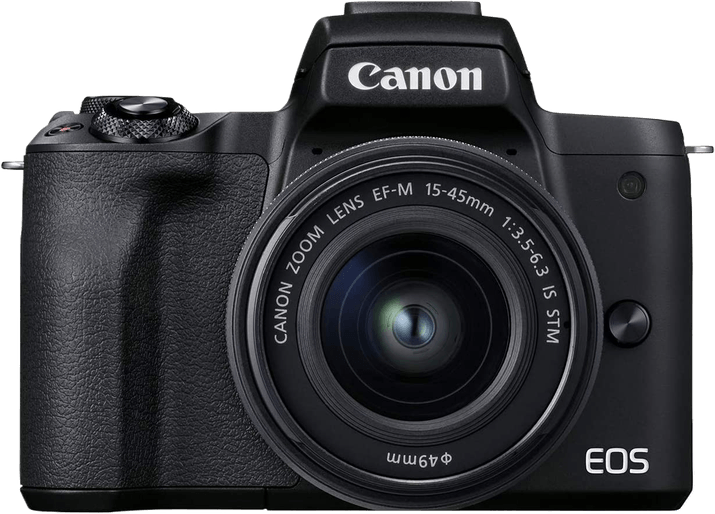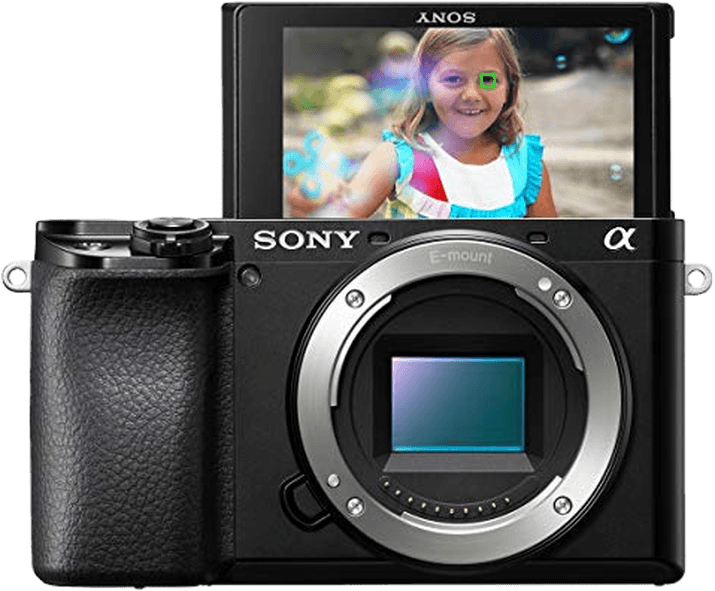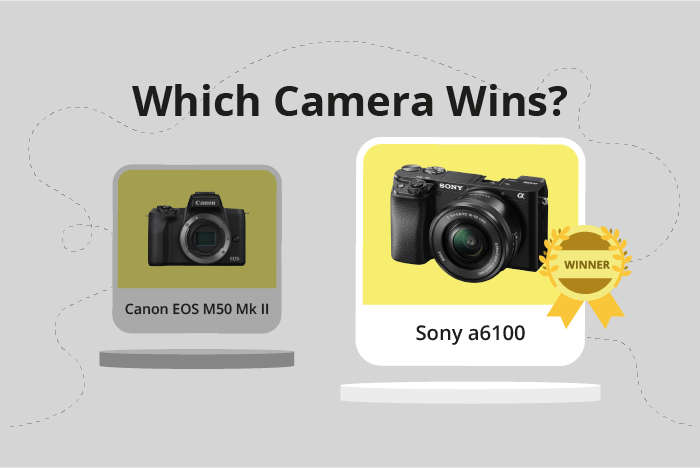Canon EOS M50 Mark II vs Sony a6100 Comparison
Canon EOS M50 Mark II

Sony a6100

The Sony a6100 emerges as the winner with a score of 66/100, while the Canon EOS M50 Mark II trails behind with a score of 59/100. Both mirrorless cameras have the same launch price of $750 and similar dimensions, with the Sony a6100 measuring 120 x 67 x 59mm and the Canon EOS M50 Mark II at 116 x 88 x 59mm. The weights are also comparable, with the Sony a6100 weighing 396g and the Canon EOS M50 Mark II at 387g.
The Sony a6100 outperforms the Canon EOS M50 Mark II due to its superior autofocus system, better low-light performance, and longer battery life. On the other hand, the Canon EOS M50 Mark II has a more user-friendly interface and a fully articulating touchscreen, making it a better choice for beginners and vloggers.
Taking these factors into account, the Sony a6100 is the better option for more experienced photographers seeking better performance, while the Canon EOS M50 Mark II caters to those prioritizing ease of use and vlogging capabilities.
Canon EOS M50 Mark II vs Sony a6100 Overview and Optics
The Sony a6100 outperforms the Canon EOS M50 Mark II in optics with a score of 68/100, a difference of 9 points from the Canon’s score of 59/100. Both cameras share several specifications, including 24-megapixel sensors, CMOS sensor types, APS-C sensor sizes, and the absence of image stabilization. However, the Sony a6100 has distinct advantages that contribute to its higher score.
The Sony a6100 possesses an edge in shooting speed, with 11 frames per second compared to the Canon’s 10 frames per second. This slight advantage allows for capturing fast-moving subjects with more precision. The a6100 also benefits from a superior DXOMARK sensor score of 82, compared to the Canon’s 58. This difference indicates better overall image quality and low-light performance.
Despite these advantages, the Canon EOS M50 Mark II has its own strengths. It features a Digic 8 processor, which, although not directly comparable to the Sony’s Bionz X processor, still delivers fast performance and quality image processing. The camera also uses the Canon EF-M lens mount, offering compatibility with a range of Canon lenses.
The lens mount for the Sony a6100 is the Sony E mount, which provides access to an extensive selection of Sony lenses. Although both cameras have their respective lens ecosystems, the Sony a6100 has the advantage in terms of overall optics performance due to its better shooting speed and DXOMARK sensor score.
Comparing the optics of the Canon EOS M50 Mark II and the Sony a6100, the a6100 is the clear winner. Its superior shooting speed and sensor performance make it a better choice for those prioritizing image quality and capturing fast-moving subjects. However, the Canon EOS M50 Mark II remains a reliable option for those already invested in the Canon lens ecosystem or who prefer its processor.
Canon EOS M50 Mark II vs Sony a6100 Video Performance
When comparing the Canon EOS M50 Mark II and the Sony a6100 for their video capabilities, both cameras tie with a video score of 91/100. This result shows that they offer similar performance in terms of video shooting.
The Canon EOS M50 Mark II and the Sony a6100 share several common video specifications. Both cameras have a maximum video resolution of 4K and video dimensions of 3840 x 2160. Additionally, they can record at a maximum video frame rate of 120fps and have built-in time-lapse functionality.
Despite the similar scores, there are areas where one camera excels over the other. The Canon EOS M50 Mark II offers an edge in terms of user-friendly features and menu navigation, making it easier for beginners and casual users to operate. It also has a reputation for producing excellent color reproduction, resulting in visually appealing videos.
On the other hand, the Sony a6100 stands out for its superior autofocus system, which ensures that subjects remain sharp and in focus during video recording. This feature is particularly useful for action and sports videography, where fast and accurate focus is crucial.
In comparing the video capabilities of the Canon EOS M50 Mark II and the Sony a6100, it is evident that both cameras provide strong performance in this area. While the Canon offers a more user-friendly experience and better color reproduction, the Sony excels in autofocus performance. Ultimately, the choice between these two cameras depends on the specific needs and preferences of the user.
Canon EOS M50 Mark II vs Sony a6100 Features and Benefits
The Canon EOS M50 Mark II wins in the features comparison with a score of 70/100, while the Sony a6100 scores 68/100. Both cameras share several common specifications, including a 3-inch screen size, touchscreen capabilities, flip screen, and the absence of GPS. Additionally, they both come with WIFI and Bluetooth connectivity.
The Canon EOS M50 Mark II outperforms the Sony a6100 in terms of screen resolution, boasting 1,040,000 dots compared to the Sony’s 921,600 dots. This higher resolution provides a clearer and sharper display, making it easier for users to review images and navigate the camera’s menu.
On the other hand, the Sony a6100 still has its merits, even though it does not surpass the Canon EOS M50 Mark II in the features comparison. It matches the Canon model in essential aspects, such as screen size, touchscreen, flip screen, WIFI, and Bluetooth. This similarity in specs indicates that the Sony a6100 is still a reliable option for photographers who prioritize these features.
Taking these factors into account, the Canon EOS M50 Mark II emerges as the better camera in terms of features, primarily due to its higher screen resolution. However, the Sony a6100 remains a strong contender, as it shares many essential specifications with the Canon model. Users should weigh their preferences and priorities when choosing between these two cameras, as both offer valuable features for different photography needs.
Canon EOS M50 Mark II vs Sony a6100 Storage and Battery
The Sony a6100 wins in the storage and battery category with a score of 37/100, while the Canon EOS M50 Mark II scores 21/100. Both cameras have one memory card slot and accept SD, SDHC, and SDXC cards. However, the Sony a6100 also supports Memory Stick Pro Duo cards, offering more storage options.
The Sony a6100 has a longer battery life of 420 shots, compared to the Canon EOS M50 Mark II’s 305 shots. Additionally, the a6100 features USB charging, making it more convenient to charge on-the-go.
The Canon EOS M50 Mark II does not offer any advantages in storage and battery over the Sony a6100. Its lower battery life and lack of USB charging limit its usability in comparison.
Considering the storage and battery aspects, the Sony a6100 proves to be the better camera. Its longer battery life, USB charging, and additional memory card compatibility make it a more practical choice for photographers.
Alternatives to the Canon EOS M50 Mark II and Sony a6100
Are you still undecided about which camera is right for you? Have a look at these popular comparisons that feature the Canon EOS M50 Mark II or the Sony a6100:

